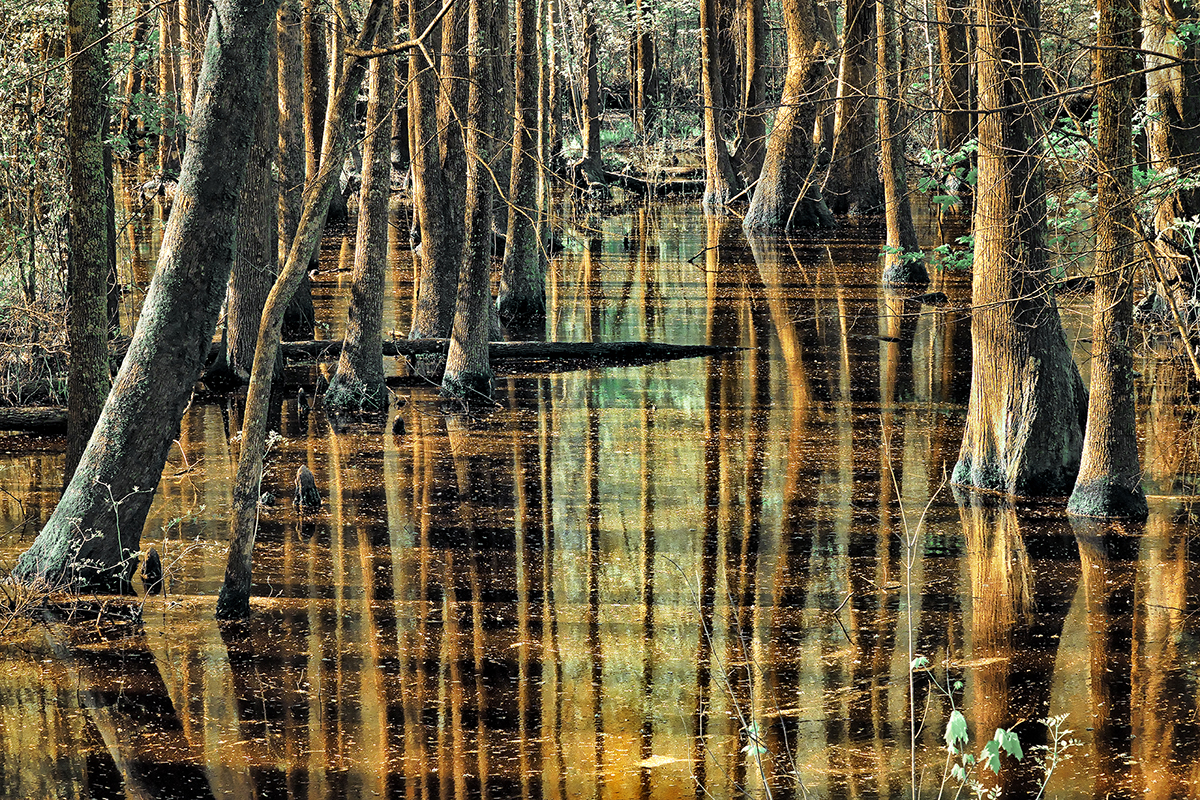The Infrared Explorer
Russell Hart explores the world from a different perspective with his Tamron SP 24-70mm VC G2, SP 70-200mm VC G2, and SP 150-600mm VC G2 lenses.
More Photo Tips | Video Gallery | Photo Gallery | Enewsletter sign-up
By Jenn Gidman
Images by Russell Hart
Since the 1970s, Russell Hart has been fascinated with infrared photography, in which the film or camera’s image sensor records wavelengths invisible to the eye. It has often been used, especially for black-and-white pictorial purposes, to dramatize or even invert the tonality of a scene—making foliage very light, for example, and with filtration turning blue sky dark so that clouds “pop.” “Infrared has always had its own vocabulary,” says Russell, who switched from film to digital infrared 15 years ago. “But digital capture has added a lot more flexibility to IR photography in terms of what you can do with the tone scale. My film infrared photographs were often very dramatic, with black skies and glowing white objects, but with digital I often find myself opting for more of a middle scale. And because the RAW files are in color, I do some color work now, which I never did with film because its effects were too crazy.”
For years Russell used a digital DSLR that was converted to capture infrared, but he’s since switched to IR-converted mirrorless cameras, using an adapter for his Tamron SP 24-70mm VC G2, SP 70-200mm VC G2, and SP 150-600mm VC G2 lenses. He had already found the focal length range of the first two lenses ideal for his type of photography, and once he added the 150-600 into his arsenal, it only enhanced his creative capabilities. “I’m typically not a big user of telephoto lenses, but this lens lets me zoom in and out to fine-tune composition, rather than picking up and moving back and forth all the time the way you have to with fixed focal lengths. That was really valuable when I was shooting surfers off of Long Island” he says. “Plus, all three of these lenses have Tamron’s Vibration Compensation (VC) feature, which is important in preserving sharpness since I shoot handheld [actually I always use the 150-600mm on a tripod—it’s too big to handhold, IMHO]. Plus they don’t create infrared hot spots in the middle of images the way many lenses do. My images with the Tamron trio always come out nice and clean.”
Read on for the backstory on some of Russell’s infrared images with this Tamron trifecta.
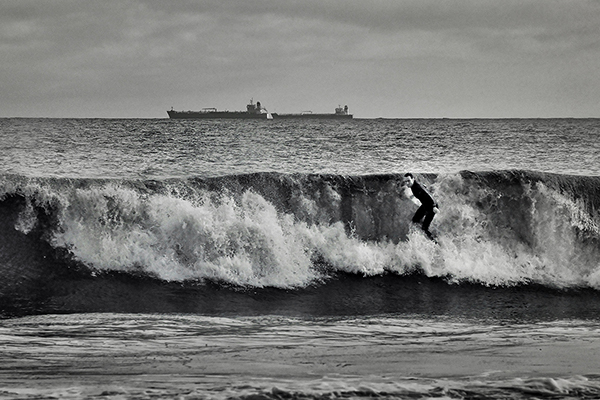
150-600mm (280mm), F/9.5, 1/750th sec., ISO 1000
Click image to view larger
There was a big storm off of Lido Beach on Long Island, and I figured the surfers would be taking advantage of the waves, so I headed down there with my camera and the big lens. I wasn’t really interested in surfing action, where I was trying to achieve tight shots of the surfers only. Instead, the tanker in the background here caught my eye in relation to the foreground and the surfer—the “figure in the landscape” idea that’s in a lot of my pictures, only in a marine setting. The 150-600 was essential in this situation. The surfers were constantly on the move, so I was able to zoom in and out to always get the framing I wanted.
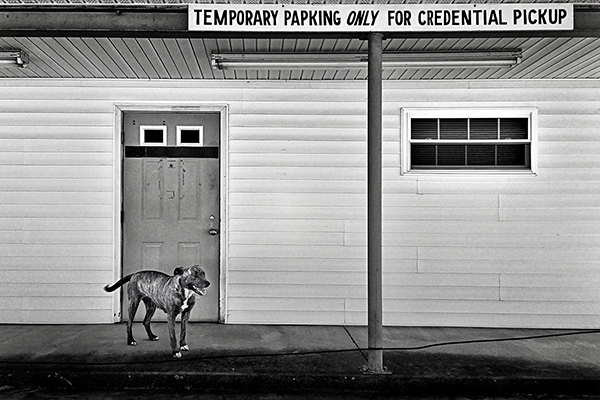
24-70mm (24mm), F/13, 1/125th sec., ISO 800
Click image to view larger
This was taken at a defunct racetrack just outside of Hillsborough, North Carolina, called the North Wilkesboro Speedway. It’s a short track that held races in NASCAR’s top three series, until it closed in 1996. I visited there and ended up following this dog around. I tend to follow dogs around, because I love taking pictures of them. It’s funny, because she looks really happy in this photo, but in other pictures I took of her she looks absolutely crestfallen. She struck the perfect pose for me.
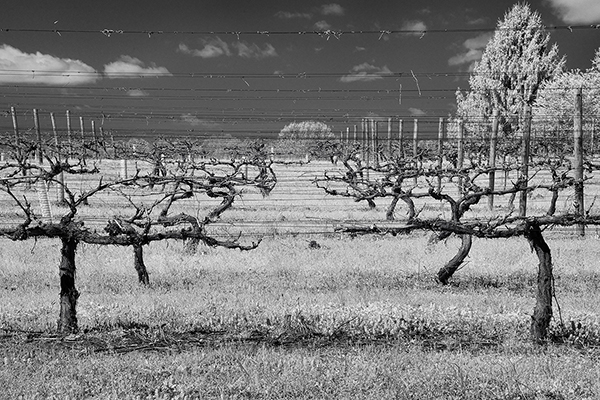
70-200mm (82mm), F/16, 1/250th sec., ISO 500
Click image to view larger
This was a vineyard in Virginia that I happened to be passing by. Grapes weren’t growing anymore at the time of year I was there, and I loved how gnarled those vines looked. I’m also drawn to receding spaces and to things that echo the horizon line, like the barbed wire was doing here. I’m a sucker for centered compositions, too, as long as they’re not static compositions. While I think off-center compositions can be great, sometimes centering things up just seems to be the right thing to do, and this scene was an example of that.
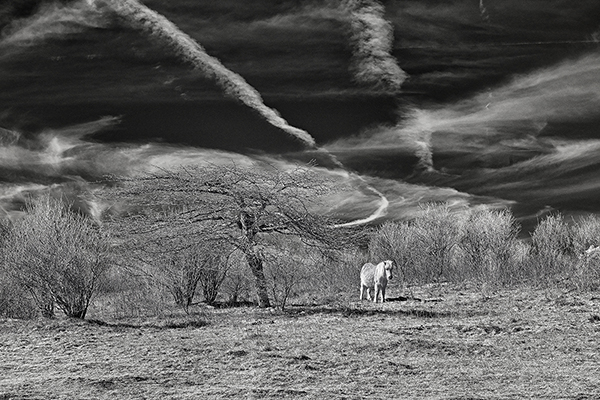
70-200mm (70mm), F/11, 1/350th sec., ISO 400
Click image to view larger
This photo was taken at Grayson Highlands State Park in Virginia, which is home to a herd of wild ponies. Like the surfer, I wanted to show the pony as a figure in the landscape instead of only showing the pony. The infrared helped enhance the cloud formations here so that the image featured an especially dramatic sky. One thing I especially appreciated is that the trees had no leaves, because it was still early spring. If they’d had leaves on them, there would’ve been a lot of white, and that would have taken away from the starkness I was looking for in this image. Instead, you get to see the linearity of the branches themselves.
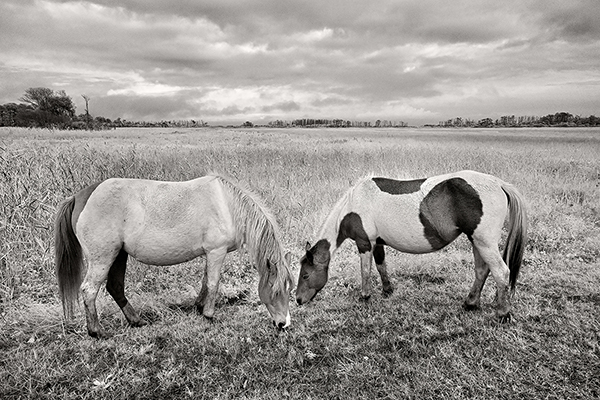
24-70mm (24mm), F/11, 1/180th sec., ISO 800
Click image to view larger
I came across these two wild horses at Virginia’s Chincoteague National Wildlife Refuge. They’re not as skittish around people as the ponies at Grayson Highlands, because more people come to see them. I liked the symmetry of this shot. I simply had to move into the proper lateral position so that their heads would slightly separate. I didn’t want their heads too far apart—just enough so that they still came together in the middle. Taken in high overcast light, this photo is also an excellent example of being able to achieve those appealing middle-gray tonalities with digital infrared.
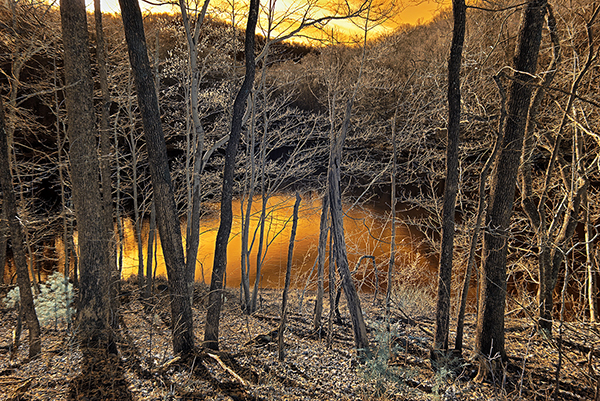
24-70mm (24mm), F/13, 1/90th sec., ISO 400
Click image to view larger
This is the type of scene where it’s obvious that color is the way to go. Even if you don’t shoot at sunset, color infrared with a digital camera tends to give you a sunset effect. Again, this scene appealed to me because the leaves were off the trees, so I was able to get that tracery of the branches. Shooting into the sun like this takes a fair amount of post-production work. Some elements get a bit burned out, so I have to go in and bring the detail back. I also usually end up doing a fair amount of tweaking of the colors when I do color infrared images. For instance, here I made the foliage a little greener than it actually was (it was a bit more blue).
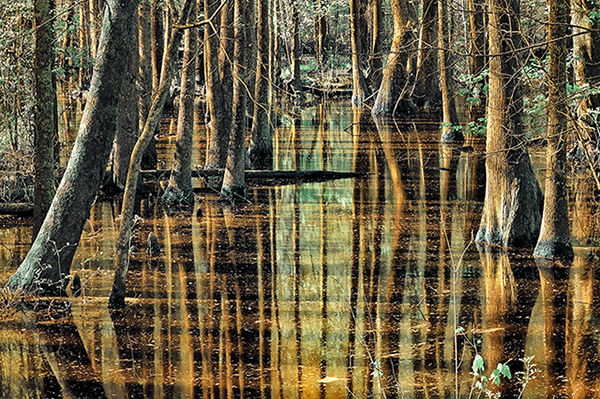
70-200mm (92mm), F/16, 1/180th sec., ISO 800
Click image to view larger
This was taken at a swamp I stumbled upon off a small country road just south of Richmond. I’ve loved swamps ever since I took a class trip in high school down to the Everglades. Swampy areas have been on my radar ever since. I liked the crosshatch of reflections and shadows here, with all of those intersecting sets of parallel lines. I wanted to use a longer lens here to compress and flatten the image a bit. I also did quite a lot of work with the color in post. I definitely tried to enhance that green. And because the scene varied in contrast—with low contrast in the water and fairly high contrast on the tree trunks—I increased the contrast in the reflections and reduced it in the tree trunks. I had to work on all of those areas individually to make them pop.
To see more of Russell Hart’s work, go to https://russellhartphoto.com or www.instagram.com/russellhartphoto.
More Photo Tips | Watch Videos | Learn More About Tamron Lenses | Photo Gallery
